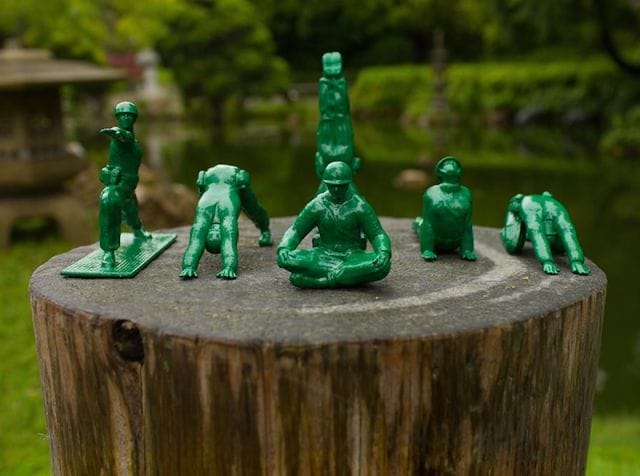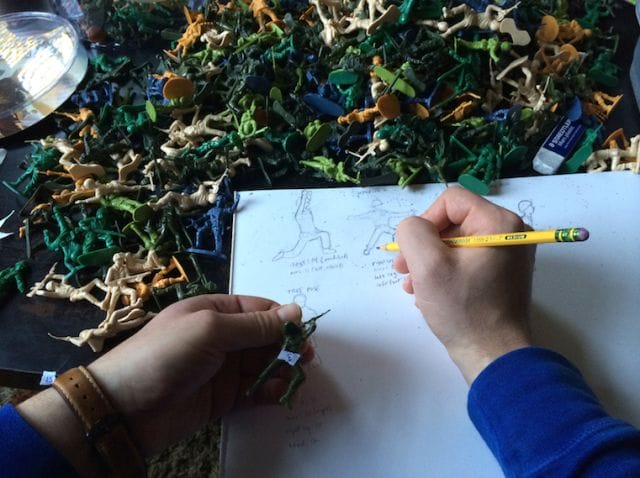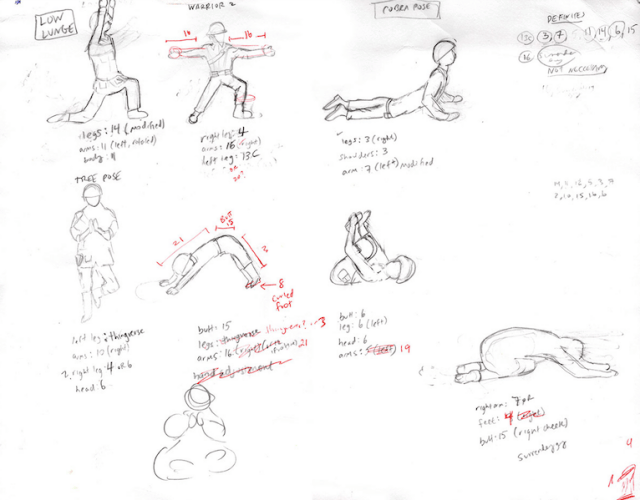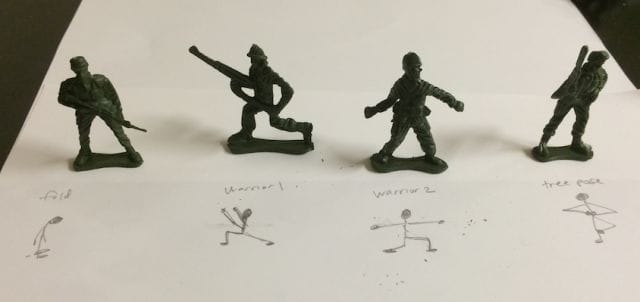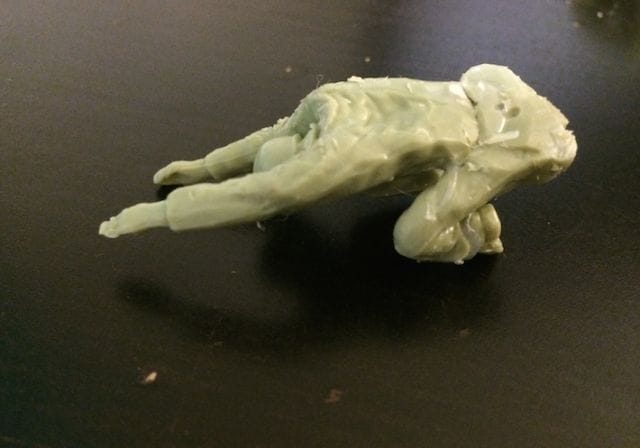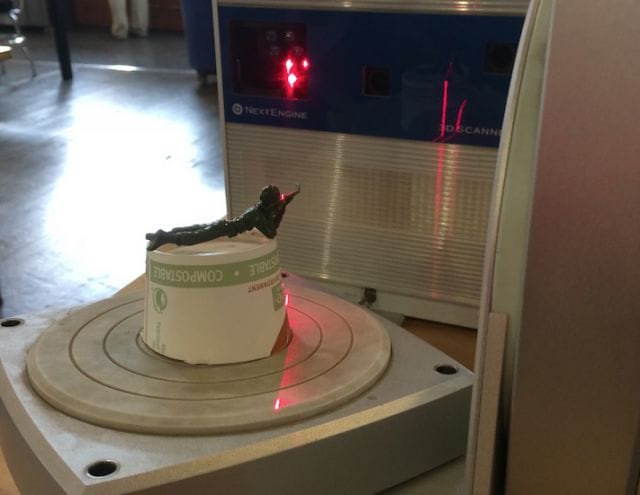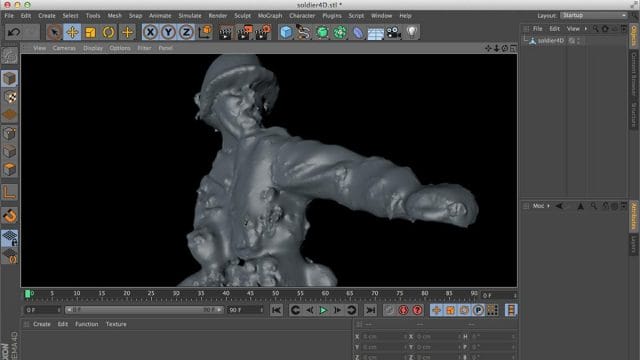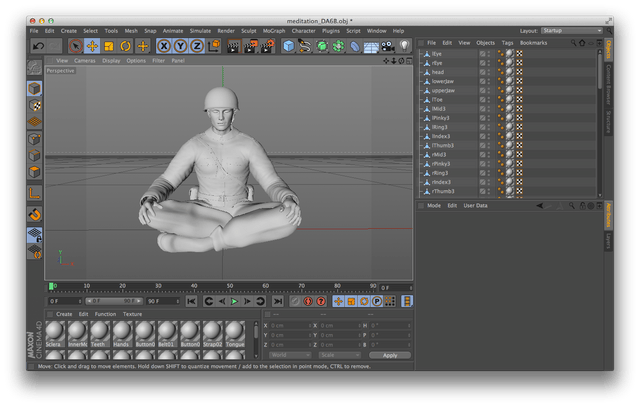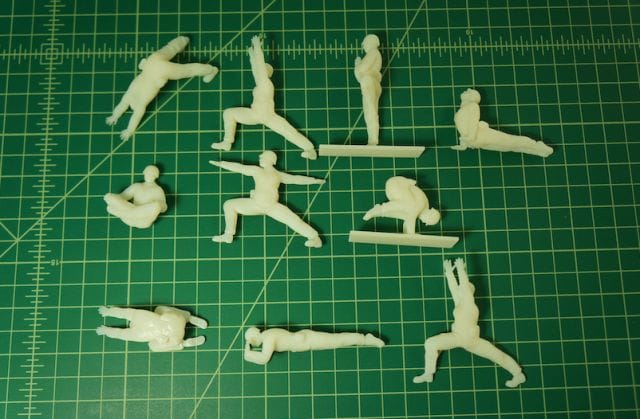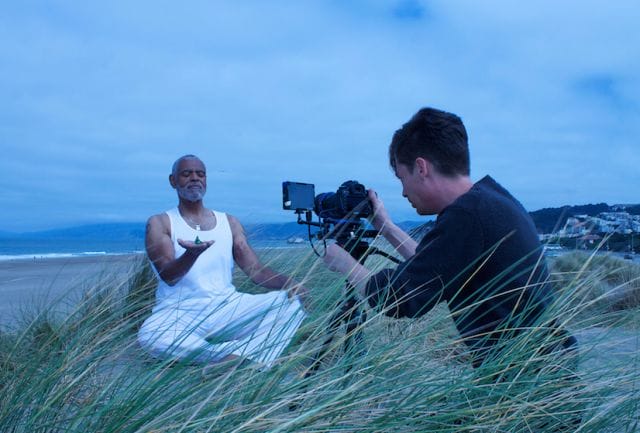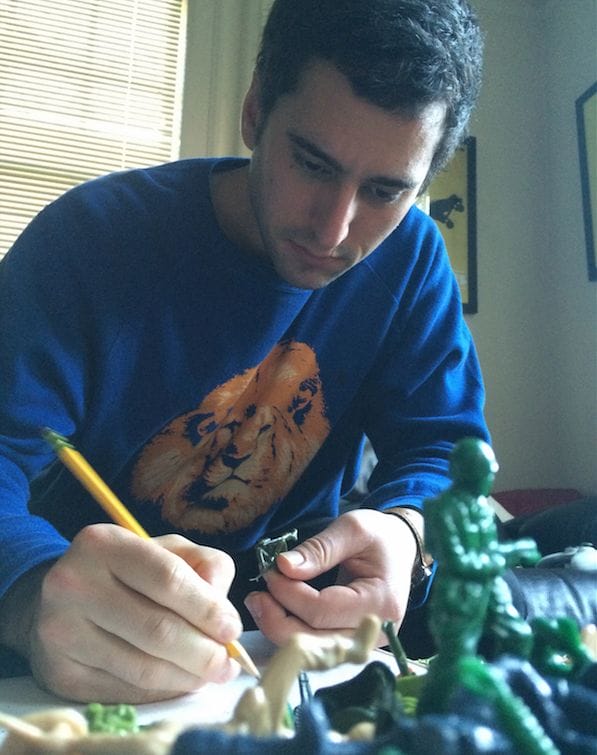Note: In April, we wrote about Dan Abramson’s endeavors with Brogamats, a company that makes yoga mats for dudes. This is his newest endeavor.
A year ago this month, Dan Abramson unleashed Brogamats on Reddit. The quirky yoga mats, designed to look like burritos, logs, and quivers of arrows, were a success for the San Francisco-based designer. After months of pinpricks, fashion jargon, and printer issues, Dan’s product found its way onto shelves at Urban Outfitters. More importantly, he’d finally realized the ultimate goal he’d set out to achieve: to shift perceptions of yoga.
Around the same time, Dan also started playing around with a new idea — an idea so novel and offbeat that the few he revealed it to thought he was off his rocker. It would take him on an Odyssean journey — from inhaling toxic fumes in a basement to hiring freelance programmers from Tunisia.
World, brace yourself for Yoga Joes.
Dissecting Joe
In October 2013, while basking in the modest, early success of Brogamats, Dan sat for coffee with his friend Paul. The two joked about the novelty of seeing unlikely characters performing yoga: cats, dogs, Hulk action figures.
Then an idea struck with the force of Thor’s hammer: army men. Paul laughed softly, but the concept stuck with Dan. The little plastic men were perfect. Molded into crouching, throwing, and stanced positions, they already somewhat resembled various yoga poses; the platforms they stood on could easily be reimagined as mats. Above all else, recalls Dan, “they were way too serious and in need of some subversion.”
Over the next few weeks, Dan was so stoked that he could hardly sleep. At first, he figured he’d simply buy a bunch of army men and see if they were remotely close to exhibiting yoga poses. He spent long hours combing the internet for army men sets, purchased a few giant bags for $20 a pop, then, like a mad surgeon, retired to his basement to create a “Franken-Army.” He sifted through the massive piles in search of similarities:
“One army man who was throwing a grenade kind of looked like he was doing a ‘warrior II;’ there was another guy with rifle who had a perfect ‘warrior’ leg — toe pointed out and everything. There was a general standing proudly with binoculars who worked well for the ‘tree pose.’ You know, things like that.”
To keep track of which men fit which poses, Dan created an elaborate numbering system, and drew out diagrams to help with categorization:
Then, he methodically matched the army men with their corresponding yoga poses — each with a “little sticker on them, with a number:”
Of course, the army men were far from correlating exactly with actual poses. Hell, they weren’t even close. Dan’s next step, at the recommendation of a designer friend, was to buy a heat gun and begin manipulating them by hand. What ensued was perhaps the goriest battle ever fought by plastic army men: limbs were dismembered, heads were cut off, and torsos were burned, melted, and twisted. No soldier was spared.
In Search of the Perfect Butt
For hours each day, Dan hunched over his workbench in a creative, noxious haze. “The basement got really plasticy,” he recalls, uneasily. “When you melt this stuff, the fumes are really toxic…my girlfriend was freaking about about me inhaling it.” Dan bought a gasmask, flung the windows open, and returned to his obsession — one that didn’t initially garner much respect:
“I had a job interview and the prospective employer asked, ‘What do you do with yourself all day, Dan?’ I answered honestly — ‘Just hanging out in my basement, melting army men’ — and I don’t think he was too thrilled…”
What’s more, he soon encountered the immense difficulty in mimicking human gestures. “A shoulder would be completely wrong — it would be bulging out, completely off. It was incredibly hard.”
An early attempt at a downward dog
Child’s pose fail
The struggle continued. Dan couldn’t, for the life of him, find a decent army man butt. While many companies produce army men sets, most come in stock poses (ie. the guy with binoculars, the guy lying down with a rifle), which makes finding certain body parts particularly difficult — including the coveted ass. “None of them had a butt,” he distressfully recounts. “I had ten or twelve sets of army men by that point, and was just scouring through them for any sign of a decent butt. My girlfriend thought i was crazy.”
Then, Dan was graced with the first of many mini-miracles. Late one night, he stumbled across a special edition Iwo Jima army set online, “the one with the guys lifting the flag:”
“I couldn’t believe it — one of the guys had a butt, and it was sticking out. I bought about ten sets, just so I could use that one guy. I just cut the butt out, and made a downward dog and a child pose. It looked like crap, but I had it.”
Dissatisfied with his hacked up, superglued prototypes, Dan refused to throw in the towel. Instead, he completely rethought his process. Days later, he was back at step one, this time, armed with technology.
The 3D Revelation
Frustrated with his “Frankenmen,” Dan pivoted strategies. Instead of attempting to physically manipulate the plastic men, he figured he’d do it digitally. He took a class on 3D scanning at TechShop (a community-based industrial equipment workspace), then ran his unaltered army men (the ones he’d numbered as being the closest to various yoga poses) through the machine. Still, the results were less than stellar:
“They always came out weird, bubbled, bulged — they looked really bad. Each one took 23 minutes to scan, and people kept walking by in heavy boots, making the machine shake, and screwing up the process.”
An imprecise scan
Then came Dan’s second mini-miracle. While killing time waiting for a scan to finish, he perused YouTube and happened across a tutorial on Daz Studio, a 3D modeling program. In the 23 minutes it took his figurine to scan, he’d already learned the basics of the program.
Dan pivoted once again — this time, without the plastic army men. It proved to be the breakthrough moment that made his vision a reality.
In the program, he started with a 3D model of a “naked man,” who could be manipulated easily with a cursor. After clicking and dragging the model into the yoga poses, Dan had to dress them in army attire. For this, he turned to a “seedy online community” which sells digital artifacts:
“It’s a whole community of people selling objects and digital poses. A lot of them are really sexualized figures, and it’s a pretty weird world to get into — but I was able to get through it.”
The quest for classical World War II attire proved challenging — his first mock-up looked more like a “1700s colonial soldier” — and it took weeks to find the appropriate helmets, shirts, and cargo pants. Dan also wanted to make sure to strip his mini warriors of their weapons, so as to encourage peacefulness and focus.
Eventually, Dan enlisted a freelance industrial designer to help out with some of the 3D rendering. The temporary hire ended up coining the “Yoga Joes” brand name.
Next on his docket, Dan had to ensure that his army men were anatomically correct from a yoga standpoint. He reached out to his yoga instructor, Stephanie Stolorow, and sent off 3D photos from every angle of every pose for her to evaluate. “Some of the army men yoga poses looked a little exaggerated at first, but they were close,” she tells us. “Kind of a Barbie effect — like an actual human body can’t look in some ways that a plastic one can.”
With Stolorow’s go-ahead on the poses, Dan headed to Moddler, a 3D printing service in San Francisco’s Dogpatch neighborhood. Here, he printed his first set of Yoga Joes in ten poses: downward dog, childs pose, meditation, cobra pose, headstand, warrior 1, warrior 2, crow pose, tree pose, and forward lunge (later discontinued). Each figurine ranged from $40 to $75 to produce, depending on software issues encountered.
Dan was generally pleased with the results, save for one detail: a few of the figures, set on army men-like bases, didn’t stand up straight. Digging deeper into his pockets, he commissioned another freelancer to design a 3D yoga mat for his little dudes to stand on.
Breaking the Mold
Armed with a great-looking set of yoga army men, Dan forayed into the final step of his vision: mass production. But at $40-75 each, 3D printing wasn’t a viable option to accomplish his goal of making 2,000 of each figurine. He had to make a custom mold.
But in order to be approved by the mold company, the 3D files needed to be converted from “a hollow shell to a solid piece of software” — an action that was nearly impossible:
“I scoured the dregs of Elance and oDesk to find someone who could do this one, specialized thing. I hired all these guys from India, Tunisia, Ukraine — nobody could do it. They said they could, then they’d just end up baffled by it.”
Finally, Dan found a guy in Boston (at a considerably higher hourly rate) who performed the task — all just to get a quote from Fathom, the molding company. The price came with sticker shock: since Dan was interested in a “family mold” (all of the army men in one mold), the first figurine would be $8,000, and each subsequent one would be $4,000. The mold for the yoga mat stands would be an extra $4,000, placing the grand total somewhere north of $40,000.
Kickstarting Yoga Joes
When big toy companies are entertaining an idea for a new product, they have the resources to conduct large-scale market research; Dan, as a lone ranger, turned to Kickstarter to test demand for his Yoga Joes. But to make his product stand out on the Interwebs, he needed a killer video.
The filming process was almost as complex as creating the toy. He connected with a comedy writer friend and a few ex-co-workers from his old ad agency, lined up an ambitious script requiring an array of oddities — an “old white-bearded yogi,” a mechanical bird, and a life-sized army suit among them. Then, he spent weeks working out finite issues, from the precise shade of his green face paint to dealing with an “enterprising magician” who had a monopoly on the battery-powered pigeon market. (He ended up purchasing a wind-up rainbow-colored bird, painting it white, and reconstructing its delicate wings with parchment paper.) At times, he questioned his dedication:
“I was at a point where I was running out of money. I was doubting myself a little bit and started to think what I was going to do for a living. But, this is an accomplishment: I’m making a green suit, I’m making a frickin’ robot dove, I’m crafting a diorama of other action figures doing yoga, I’m hiring an old Indian man to pose on a beach. All the things we wanted to do, we did.”
Between prototyping and videography, Dan’s invested about $3,000 of his own money, and hundreds of hours of his time — but for him, this was a small price to pay to carry out a childhood dream. “I’ve always wanted to make a toy,” he tells me over dinner. “Now I’ve made one. That’s pretty cool.”
But to see the vision through to the end, Dan needs $40,000 for his molds — cash he simply doesn’t have. He hopes the Kickstarter community will appreciate his efforts.
A set of six Yoga Joes (downward dog, child’s pose, meditation, cobra pose, headstand, and warrior 2) will sell for $20, and will come with a display case and a bamboo “yoga studio” mini-floor. Active duty and retired military will be able to buy Yoga Joes for half price. (Interestingly, yoga has a longstanding history of being used to treat PTSD in real soldiers. Organizations like Warriors at Ease, and Yoga Warriors have used the activity to mentally and spiritually heal distressed minds.)
Additionally, for a donation of $200, Dan will offer any custom yoga pose; as with Brogamats, he wants to see the community shape the future of his product. Just as he tells me this, the waiter interrupts our conversation, motioning to the army men splayed across the table. “Dude,” he says, with a head nod, “Are those…army men doing yoga? That’s badass.”
Rebranding Yoga
Yoga Joes are more than a quirky toy — they’re a philosophy, a major player in Dan’s quest to deconstruct the stereotypes of yoga. “Yoga is for everyone,” he says, “and the product is about getting people to do yoga who don’t normally do it. You mix two things that typically don’t go together.”
Army men and yoga, on a surface level, certainly fit the bill. The “tough guy” perception of the toy and the harmonious, peaceful perception of the activity don’t particularly seem to meld. But Dan sees things a bit differently. “The warrior and yoga coincide,” he argues. “There’s something very macho about being focused and disciplined.”
Like most inventors, Dan has become a part of his own invention. It’s a transformation that’s been both literal (over the course of his Kickstarter video, he slowly transforms into a life-size, shiny green Yoga Joe), and metaphorical.
From incubation to literally cradling his new-born resin prototypes, Dan has cared for his product for over a year. He’s toiled in toxic basements with heat guns, slogged through 3D modeling software, and risen at the crack of dawn to negotiate with overseas freelancers. Ultimately, through his creative pursuit, he’s straddled the divide between warrior and yogi: disciplined, focused, unrelenting.
“I just wanted to make something tangible,” he says, gently laying a headstand Joe on its side, “something strong, real — something that lasts and survives.”
This post was written by Zachary Crockett. Follow him on Twitter here, or Google Plus here.




